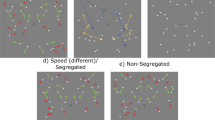Abstract
In visual fields composed of dots spatially randomly distributed but moving rigidly, the percept of coherent motion is lost once Dmax is exceeded, resulting in an incoherent, random percept. We have investigated this transition both from a psychophysics perspective and in the development of a dynamic model of the visual system based on a spatially coupled array of nonlinear damped mass-springs cells. We present results of experiments using rigidly moving arrays of dots of different levels of sparseness and differing displacement magnitudes. Results show that the perception of randomness can be reliably judged and displays a transition from coherent to non-coherent motion as the motion amplitude is increased. Using standard psychophysical just noticeable difference (JND) judgements, we noted that the threshold JND was a function of displacement magnitude and sparseness and could not be explained by extant spatiotemporal filtering models. Our model qualitatively explains the important features of the data, reproducing the experimental Dmax and entropy perception effects with increased stimuli motion amplitude at different spatial sparseness levels. We have then performed some numerical simulations of the model when the masses in the array are randomly distributed. Results show that sparseness plays different role if close or far from Dmax in terms of motion coherence discrimination.
Similar content being viewed by others
References
R.H. Wurtz, Vision Res. 48, 2070 (2008)
D.M. Snodderly, Vision Res. 118, 31 (2016)
S. Aoki, A. Kawano, M. Terao, I. Murakami, J. Vis. 16, 1 (2016)
I. Murakami, P. Cavanagh, Vision Res. 41, 173 (2001)
I. Murakami, P. Cavanagh, Nature 395, 798 (1998)
L. Glass, Math. Intell. 24, 37 (2002)
N. Davidenko, N. Heller, Y. Cheong, J. Smith, J. Vis. 17, 1 (2017)
L. Dugué, R. VanRullen, J. Vis. 14, 1 (2014)
K. Nakayama, G.H. Silverman, Vision Res. 28, 747 (1988)
S. Martinez-Conde, S.L. Macknik, D.H. Hubel, Nat. Rev. Neurosci. 5, 229 (2004)
S. Cerutti, V. Bersani, A. Carrara, D. Liberati, J. Biomed. Eng. 9, 3 (1987)
E.P. Simoncelli et al., J. Cogn. Neurosci. 3, 1 (2004)
R. Sekuler, S.M. Anstis, O.J. Braddick, T. Brandt, J.A. Movshon, G. Orban, in Visual Perception: The Neurophysiological Foundations (Academic Press, Cambridge, Massachusetts, USA, 1990), pp. 205–230
B. Franceschiello, A. Sarti, G. Citti, J. Math. Imaging Vis. 60, 94 (2018)
P. Martineau, M. Aguilar, L. Glass, Phys. Rev. Lett. 103, 1 (2009)
P. Martineau, J. Comput. Neurosci. 31, 273 (2011)
D. Stephen, J. Dixon, R.W. Isenhower, J. Exp. Psychol. Hum. Percept. Perform. 35, 1811 (2009)
J.J. Johnson IV, A. Tolk, A. Sousa-Poza, Procedia Comput. Sci. 20, 283 (2013)
E.J. Brändas, Quantum Biosys. 6, 160 (2015)
R. Jerath, M.W. Crawford, V.A. Barnes, Front. Psychol. 6, 1204 (2015)
R.A. Eagle, J. Opt. Soc. Am. A 13, 408 (1996)
M. Morgan, Nature 355, 344 (1992)
H. Haken, in Principles of Brain Functioning: A Synergetic Approach to Brain Activity, Behavior and Cognition (Springer Science & Business Media, Berlin/Heidelberg, Germany, 2013), Vol. 67
W. Freeman, Neurodynamics: An Exploration in Mesoscopic Brain Dynamics (Springer Science & Business Media, 2012)
D.G. Stephen, J.A. Dixon, R.W. Isenhower, J. Exp. Psychol. Hum. Percept. Perform.35, 1811 (2009)
T.N. Cornsweet, Am. J. Psychol. 75, 485 (1962)
M. Morgan, M. Fahle, Proc. R. Soc. Lond. B 248, 189 (1992)
R. Wozniak, Classics in Psychology 1855–1914: Historical Essays (Thoemmes Press, London, United Kingdom, 1999)
W.J. Freeman, Mass Action in the Nervous System (Elsevier Science & Technology Books, New York, 1975)
W.J. Freeman, How Brains Make Up Their Minds (Columbia University Press, New York, USA, 2000)
R. Núñez, W.J. Freeman, The Primacy of Action, Intention and Emotion (Imprint Academic, Thorverten, UK, 1999)
K. Pribram, Mind Matter 2, 7 (2004)
R. Engbert, R. Kliegl, Psychol. Sci. 15, 431 (2004)
R.A.M. Gregson, n-Dimensional Nonlinear Psychophysics: Theory and Case Studies (Lawrence Erlbaum Associates Inc., Mahwah, USA, 1992)
A.J. White, H. Sun, W.H. Swanson, B.B. Lee, Invest. Ophthalmol. Vis. Sci. 43, 3590 (2002)
R.A. Gregson, L.A. Britton, Percept. Psychophys. 48, 343 (1990)
C. Baker, J. Boulton, K. Mullen, Vision Res. 38, 291 (1998)
H. Lamba, Physica D 82, 117 (1995)
J.D. Victor, R.M. Shapley, B.W. Knight, Proc. Natl. Acad. Sci. 74, 3068 (1977)
M.H. Hennig, K. Funke, F. Wörgötter, J. Neurosci. 22, 8726 (2002)
Y. Fukushima, K. Hara, M. Kimura, Biol. Cybern. 54, 91 (1986)
B. Lee, A. Elepfandt, V. Virsu, J. Neurophys. 45, 807 (1981)
J.A. Perrone, J. Vis. 5, 3 (2005)
S. Prince, S. Offen, B.G. Cumming, R.A. Eagle, Perception 30, 367 (2001)
C. Baker Jr, A. Baydala, N. Zeitouni, Vision Res. 29, 849 (1989)
J.B. Demb, P. Sterling, M.A. Freed, J. Neurophys. 92, 2510 (2004)
E. Simonotto, M. Riani, C. Seife, M. Roberts, J. Twitty, F. Moss, Phys. Rev. Lett. 78, 1186 (1997)
F. Moss, L.M. Ward, W.G. Sannita, Clin. Neurophysiol. 115, 267 (2004)
A. Dunin, T. Hine, P. Celka, Aust. J. Psychol. 58, 73 (2006)
Author information
Authors and Affiliations
Corresponding author
Rights and permissions
About this article
Cite this article
Celka, P., Hine, T. The perception of entropy in rapidly moving sparse dot arrays: a nonlinear dynamic perspective. Eur. Phys. J. Spec. Top. 227, 865–881 (2018). https://doi.org/10.1140/epjst/e2018-800020-0
Received:
Revised:
Published:
Issue Date:
DOI: https://doi.org/10.1140/epjst/e2018-800020-0




